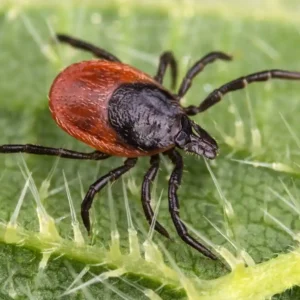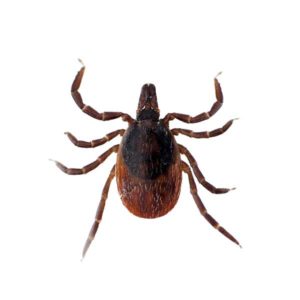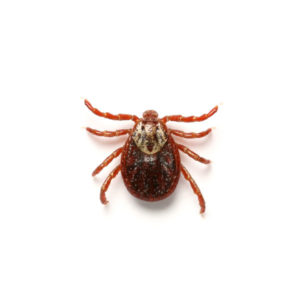Identifying Fleas in Florida
Fleas are small, wingless blood-sucking parasites that live on the exterior of their host. Fleas can sometimes be confused with ticks or mites, so proper identification of ticks, mites, and fleas is important.
Adult fleas feed only on the blood of warm-blooded hosts, which they must obtain in order to survive and reproduce. Fleas are the most common ectoparasites found on cats and dogs, so they frequently turn up as household pests.
Fleas are annoying to people and pets, especially during spring and early summer when their numbers tend to increase dramatically.
If you suspect a flea infestation, consider professional pest control services to help with the issue. Protect your family and pets with Florida Pest’s flea control.
What Do Fleas Look Like?
Fleas are small, wingless insects, about 1/8 inch long, with flat, reddish-brown bodies. They have strong legs for jumping and are often seen darting through fur or carpets. Their small size can make them hard to spot without close inspection.
Signs of a Flea Infestation
Common signs include excessive scratching in pets, red bite marks on humans, and flea dirt (black, speck-like droppings) in pet bedding or carpets. You may also notice fleas hopping on your pet or in areas where they rest.
Where in Florida Do Fleas Live?
Fleas are prevalent across Florida due to its warm, humid climate, which provides the perfect conditions for their life cycle. These pests thrive both outdoors and indoors, creating challenges for pet owners and homeowners alike.
Preferred Habitats
Fleas thrive in many climates but prefer moist, humid, and shady areas. The area underneath a porch or deck can turn into an overwintering site. Areas with tall grass, leaf litter, weeds, wood piles, gravelly areas, and sandy patches are all attractive to fleas.
Even the tiniest crack in the concrete can harbor fleas and they especially like shrubs, leaves, and trees, but do not fare well in sunny areas or open grass.
Fleas usually enter structures attached to pets, and they can quickly find refuge in homes. Flea larvae do not like the light so carpets, bedding, pet beds, and upholstered furniture make cozy homes for fleas, flea eggs, and flea larvae.
Are Fleas Dangerous?
Fleas are more than just a nuisance; they can pose risks to both pets and humans. Their bites cause itching, irritation, and allergic reactions, and they can also serve as vectors for diseases and parasites.
Do They Spread Diseases?
Though they may trigger allergic reactions, flea bites will not often have a serious impact on a person’s health.
Fleas feed mainly on non-human animals but may bite and infect humans. Bites from fleas look like small red dots and may occur in two or three groups or clusters around feet, ankles, and legs. However, some people and pets suffer from flea bite allergic dermatitis, characterized by intense itching, hair loss, reddening of the skin, and secondary infection.
One flea bite can initiate an allergic reaction, and itching can persist for up to five days after the bite.
How to Get Rid of Fleas in Florida
To eliminate fleas effectively:
- Treat your pets: Use veterinarian-recommended flea treatments, such as oral medications, topical solutions, or flea collars.
- Vacuum thoroughly: Focus on carpets, furniture, and cracks in floors where fleas and eggs may hide. Dispose of the vacuum bag immediately.
- Wash pet bedding: Launder your pet’s bedding and toys in hot water to kill fleas and eggs.
- Treat outdoor areas: Use pet-safe insecticides in shady, moist areas where fleas thrive, such as grass, leaf litter, or under porches.
- Repeat treatments: Follow up regularly to address any remaining flea life stages and prevent re-infestation.
Flea Prevention Tips
Preventing fleas involves regular pet care and household maintenance. Use flea prevention products year-round, groom pets frequently, and maintain a clean environment by vacuuming and washing pet bedding weekly.
Outdoors, keep grass trimmed, and remove debris to reduce flea habitats. Check pets for fleas after outings, especially in high-risk areas.
Need more help? Discover effective strategies for preventing fleas in your home.
Need Help with Flea Control in Florida?
If you are dealing with a flea infestation, contact your local flea exterminators for help. Don’t wait—contact Florida Pest today!
Dealing with ticks instead of fleas? Learn more about our tick control services across Florida.
FAQs
What kills fleas instantly in the house?
While household solutions like dish soap mixed with water can trap fleas when placed in shallow dishes under light, professional pest control is advised to eliminate fleas completely.
To prevent fleas from entering your home, vacuum carpets, furniture, and cracks often and wash pet bedding in hot water.
Are fleas a problem in Florida?
Yes, fleas are a significant problem in Florida due to the state’s warm, humid climate, which provides the ideal environment for fleas to thrive. Cat fleas are the most common species, often infesting pets and homes.
Without proper control, fleas can multiply quickly and cause irritation, allergic reactions, and even anemia in pets.
How do I know if I have fleas?
Signs of fleas include excessive scratching by pets, red bite marks on humans, and spotting fleas jumping on furniture, carpets, or pets. Look for flea dirt—small black specks resembling pepper—in pet fur or bedding.
You can confirm by combing your pet with a flea comb and inspecting for fleas or dirt.
Are fleas harmful to humans?
Flea bites can cause itching, irritation, and allergic reactions. While their primary hosts are animals, humans can experience discomfort and health risks from infestations.
Can fleas live in human hair?
Fleas rarely live in human hair. They prefer animal hosts with fur, but in severe infestations, fleas may bite the scalp.
If fleas are found in hair, thorough washing with medicated shampoo and treating the environment is necessary to eliminate them completely.





